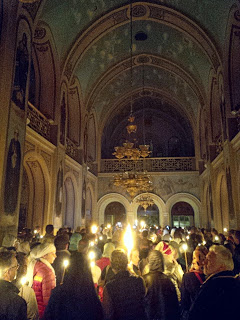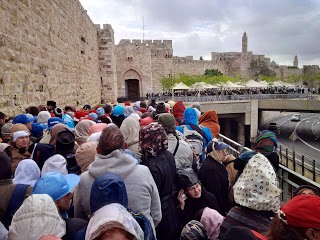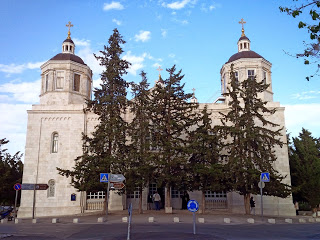
My arrival in Jerusalem on Wednesday marked the end of daily walking with my pack on my back. Thursday morning, I walked from the hostel to the Church of the Holy Sepulchre, which was the marker I’d set when calculating the distance remaining. Saturday evening (and well into Sunday morning), I fulfilled the stated goal of this pilgrimage, which was to celebrate Pascha in Jerusalem.
My pilgrimage is over, but I have another twelve days before my flight is scheduled to leave Amman, Jordan. I haven’t seen much of Jerusalem yet — between getting to Holy Week services and sleeping, I’ve been too busy for sightseeing. Given the sleep deprivation associated with Holy Week and Pascha, I think I’ll be getting quite a bit more rest in the coming days. (Plus, I think I may be getting sick. Two days ago I started feeling that hot scratchiness in the back of my throat, and it hasn’t gone away.)
On Thursday when I walked to the Church of the Holy Sepulchre, I had noticed a sign in several languages stating that entrance to the Holy Fire ceremony was only through the Jaffa Gate. I joined the lineup there at 9:00 Saturday morning, hoping that the five hours of waiting before the service would pay off. There are three pedestrian approaches to the Jaffa Gate and each one had a police barricade set up. I was at the westernmost one, which was also the most crowded. Funny thing about crowds — they’re frighteningly stupid. There was one large tour group which arrived about an hour after I did and immediately began trying to get closer to the barricade. Everyone’s personal space vanished and a few shoving and shouting matches erupted. Around noon, a group of people left the front of the queue and began working their way back through the crowd. I recognised one of them as the Serbian woman I’d met at the hostel two days earlier. This is her third visit to Jerusalem, so I figured her departure meant she knew something I didn’t. I made a note of the direction she was heading, but before going that way myself I paused at one of the other Jaffa Gate barricades. The crowd was much thinner there and I was able to approach and speak with one of the Israeli police officers. He told me the barriers would remain in place until two or three o’clock in the afternoon. That, of course, meant that none of the people waiting would be able to attend the service, which had been my experience Friday morning. [Side note: before coming I had been told that a) it was impossible to get inside the church for the service without special permission and b) that it was possible to get in, once all the VIPs had been admitted. After arriving back at the hostel Saturday afternoon, I heard from a friend in Poland who had witnessed the service the two previous years.]
I wound up entering the Old City by the Dung Gate, near the Western Wall, the other gates also being closed. The twisty narrow streets of the Muslim Quarter were easy to navigate with my GPS app, but all the roads and alleys leading to the Holy Sepulchre had roadblocks with Israeli police allowing people through only after being satisfied they were not heading to the church. (Muslims and Jews only, basically.) As I was winding my way through the Old City, a boy spotted me and asked if I was looking for the church. He promised me he could get me there, and not having any other options, I decided to see where he would lead me. We backtracked a bit, and then he took me into what seemed to be a dead end. In the corner of the alley was a narrow flight of stairs leading to the rooftop over the souq. After shaking me down for money (which I expected), he pointed out another staircase which he said I should take after waiting a few minutes. When I headed towards it, I was disappointed to see a police officer sitting beside it, with another barricade and more police at the bottom of the stairs. Since it was just the two of us, I decided to appeal to him, in the hope that he would let me through to try my luck at the next roadblock. I showed him my notebook of stamps documenting my progress over the last seven months, and while he was impressed, he wasn’t impressed enough to violate his orders and let me by.
I had left Jaffa Gate at noon, and spent an hour and a half trying to find a way in. I knew that the Russian cathedral would be receiving the Fire at 2:30, so I had just enough time to get there. The fuss about this particular service may seem a little odd to my non-Orthodox readers, so here is a site which gives some background.
www.holyfire.org/eng/index.htm
Wikipedia also has a write-up, which includes various attempts to explain the phenomenon without recourse to the miraculous. While some of them are more plausible than others, none of them are able to explain everything that occurs. I was a little disappointed at not being able to witness it for myself, but this was not the focus of my pilgrimage. (An Anglican acquaintance of mine had made the comment that this event seemed out of character when compared to the miracles performed by our Lord in His earthly ministry.)
When I returned to the hostel after the service at the Russian church, I met up with my Russian roommate. He had not returned to the room at all Friday night, which I thought was a little strange. It turns out that he had spent the night in a church in the Old City, and so found himself inside the perimeter set up by the Israeli police. Yes, he made it to the service. He showed me the videos he’d shot with his smartphone which included a shot of him passing his hand slowly through the flame without harm. (This unique characteristic of the Holy Fire only lasts about half an hour before the flame begins to burn normally.) After talking a bit more, we both crashed out in anticipation of a long night ahead.
Since I had found refuge at the Russian cathedral of the Holy Trinity for other services during my stay, I decided to celebrate Pascha with them as well. Their schedule indicated that the first of the services would begin at 11:00 pm, but when I arrived at 10:30 things were already underway. As I was entering the church, I saw Marija, the Serbian woman from the hostel. She had also been unsuccessful in getting into the Holy Sepulchre earlier in the day. Apparently the thing to do (for future reference) is enter the Old City by the Dung Gate very early in the morning and just hang out as inconspicuously as possible until it’s possible to enter the church. My Polish friend told me that a good vantage point is from the gallery overlooking the Edicule, which is reached from the Golgotha chapel. There is much less crowding, and you can see the flame spreading through the crowd below.
It was almost 4:00 in the morning when I left the church and started walking back to the hostel. It had started raining overnight, but I’d stuffed my rain poncho and Tilley hat in my small pack, so I stayed dry. After the heat of the previous week, the sudden drop in temperature Thursday was a welcome surprise — the rain, not so much. I retrieved the meat and cheese I’d purchased earlier Saturday and broke the fast quietly. I also began typing this update, but fell asleep after the first paragraph.
I slept through the complimentary breakfast at the hostel Sunday morning, so I headed out to find some food. On returning, I saw Marija in the lobby. We wound up talking for an hour or so, about solo travel, liturgics, Linux, and many other topics besides. After our meeting at the cathedral the night before, she had gone on to the Church of St Mary Magdalene on the Mount of Olives. It was less crowded there, but they didn’t finish the Paschal Liturgy until 5:30 in the morning. She still hadn’t slept, and it was now approaching noon. We traded contact information and then I headed up to my room to rest a bit, and perhaps then finish this update.
At 2:00, someone else checked in to the room. Eliyahu was born and raised in an observant Jewish family in the USA. He is now a Torah-observant follower of the Messiah. His interests in etymology, biblical studies, and history meant that I didn’t do any writing Sunday afternoon. After we’d spent a few hours talking, I started getting ready to attend the Agape Vespers service at the Russian cathedral, while Eliyahu laid down for a rest. It had been raining most of the day, including a short period of hail and some lightning, but it was sunny and mild when I left for church. Two hours later, it was a different story. A strong wind had come up out of the southwest, bringing heavy rain and more lightning. I had left my poncho at the hostel, so I sheltered under a store awning until the storm abated and then scurried back to the hostel. I hung my damp outer layer from the bunkbed to dry and went downstairs to the bar, where I bought an order of “homemade” nachos. They were good, and surprisingly filling. Heading back up to my room, I began perusing the Lonely Planet guide to “Israel and the Palestinian Territories” I’d bought on the way to church. A short while later, one of the other men in the four bed dorm came in. We had talked briefly over the past few days, but Sunday evening saw us trading stories of travel. He’s heading on to Tel Aviv for a few days before flying home to Germany at the end of the week. I turned in early, as I’m still pretty tired, and the tickly throat of a few days ago has transformed into sinus congestion and a cough.
CHRIST IS RISEN!
Χριστός ανέστη!
!المسيح قام
Христос Воскресе!





